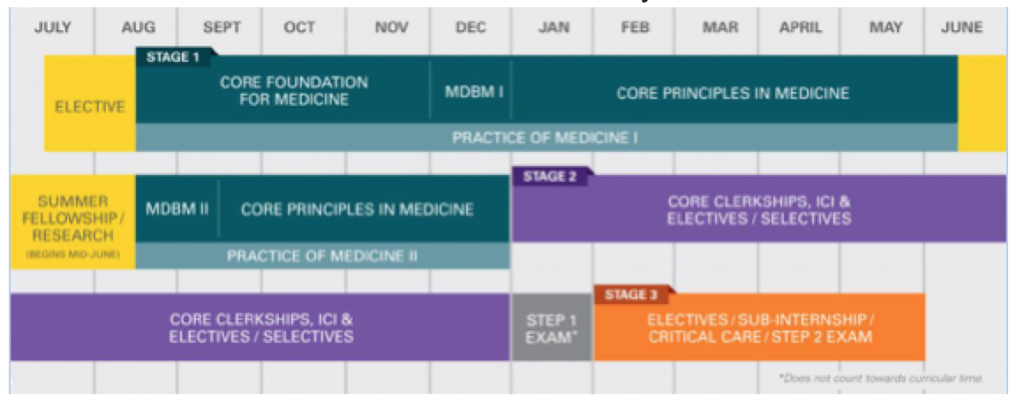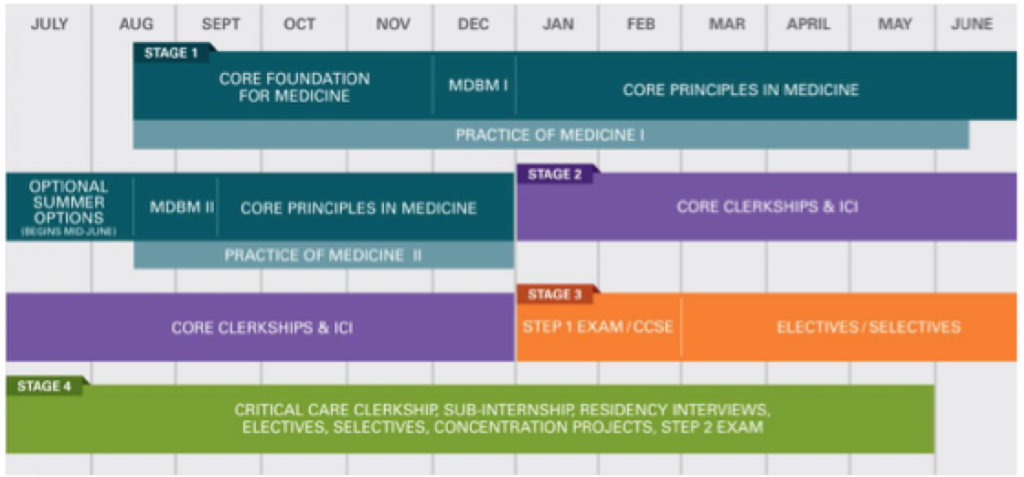The three-year medical school program is a fairly new development in medical education. And while there are many benefits to pursing these accelerated programs, but they’re not for everyone. In this blog, we will take an in-depth look at three-year MD program requirements and formats, as well as which schools currently offer this alternative, in order to determine which students it serves best.
What are Three-Year MD Programs?
Three-year MD programs satisfy a demand for shorter medical school programs. They save the student a year of tuition and living expenses (as well as a year with no income), and the student is often guaranteed a spot in a specialized residency. The education and training to become a doctor can often take up to a decade, and so taking a year off of this process is very alluring to some students.
According to the Washington Post, “Some medical school administrators and policymakers see three-year programs as a way to produce physicians, particularly primary-care doctors, faster as the new health-care law funnels millions of previously uninsured patients into the medical system.” And given that specialists are now making double the income of primary care doctors, primary care physicians are at a particular shortage.
With four-year medical programs, the last year is focused on electives and the process of securing a residency position. But there is some debate as to the value of this final year. According to Ezekial Emanuel and Victor Fuchs, writing in the Journal of American Medicine Association, “Years of [medical school] training have been added without evidence that they enhance clinical skills or the quality of care. This waste adds to the financial burden of young physicians and increases health care costs. The average length of medical training could be reduced by about 30% without compromising physician competence or quality of care.”
Which Schools Currently Offer 3-Year MD Programs?
At present, there are very few opportunities to pursue a 3-year MD program. Of all the options, NYU offers the broadest program. Most others are limited to primary care or family medicine, and some carry an obligation to practice within the state.
- NYU: 3YMD Pathway
Students must choose their residency of interest prior to application to the 3YMD Pathway. For the Class of 2018, there are 34 positions, across 20 residency programs. Students can apply at the time of acceptance or in February of their freshman year. The Three-Year Pathway program starts six weeks before the Four-Year Pathway program, and students work in a summer fellowship between their first and second year. Students can transfer to Four-Year MD pathway, if necessary, due to residency change or otherwise. The graphic below gives a detailed summary of the timeline differences between the 3-Year and 4-Year MD Pathway programs.
Three-Year MD Pathway
Four-Year MD Pathway
- Texas Tech University Health Sciences Center: Family Medicine Accelerated Track (FMAT)
FMAT’s goal is to prepare primary care physicians more efficiently with lower cost. This program culminates in the M.D. degree and leads to a standard three-year family medicine residency at one of three Texas Tech programs, in Lubbock, Amarillo, or the Permian Basin. FMAT is limited to 16 students per year in each class. Students may apply for the FMAT program when they apply for admission or during the fall semester of the MS1 year. Tech School of Medicine provides scholarship support to FMAT students for at least one year of medical school. Students may choose to return to the regular four-year program at any time. However, any FMAT scholarship support will revert to loan status and must be repaid.
- UC-Davis, School of Medicine: ACE-PC
This program is only for students committed to careers in primary care. ACE-PC students start working in Kaiser Permanente primary care clinics within the first few weeks of starting the program and continue in these clinics for three years. Unique curricular content includes population management, chronic disease management, quality improvement, patient safety, team-based care and preventive health skills with special emphasis on diverse and underserved populations. ACE-PC is limited to six students and classes begin in June. Students can apply for the program during the secondary application, and may choose to return to the four-year program at any time.
- Mercer University: Accelerated Track in Family Medicine
This program is only for students interested in practicing Family Medicine who have a strong desire to remain in Georgia. Students apply during the Spring of Year 1 and may opt to return to the four-year program at any time. The curriculum is very similar to their four-year MD program, but is compressed into 131 weeks of instructional time and offers more educational contact opportunities between students and the Family Medicine faculty.
- Columbia University: College of Physicians and Surgeons 3-year PhD-to-MD Program
Columbia’s accelerated program is only open to students who have already earned a PhD in biological sciences and intend to pursue biomedical research as a physician scientist. To this end, applicants are restricted to studying cognitive specialties, such as internal medicine, pediatrics, neurology, psychiatry, or pathology. You can apply for this program when you receive the secondary in the regular medical school application process. The program is divided into preclinical courses (18 Months), major clinical year (12 Months), and subinternship and electives (6 Months). Students begin in August of their first year and finish in May of their third year, working over the summers.
- Lake Erie College of Osteopathic Medicine: Primary Care Scholars Pathway (PCSP)
PCSP students must commit to complete a residency in family medicine or general internal medicine, and practice primary care medicine for a minimum of five years upon completion of residency. If a student does not fulfill these requirements, they will be asked to return the scholarship award (one year of medical school tuition). There are about 12 positions available in this program each year. Students complete all courses and learning modules required in the first two years of preclinical education in 18 months, as well as several courses during the summer months. Students participate in a sub-internship at the hospital where they will continue their clinical training after graduation. In addition to saving the student from paying for the fourth year of medical school, this program includes a scholarship for the third year of medical school.
In Conclusion…
Accelerated three-year medical school programs are often geared towards careers in primary care, but have the opportunity to expand to more specialties (as at NYU) as they experience increasing success. The shortened programs are extremely academically rigorous, and if students are not meeting academic benchmarks, they are transferred back to the four-year program.
Three-year medical programs mark a specialized pathway of study for those students who are already committed to the type of doctor they wish to become and who are willing to work at an advanced pace to opt out of a year of medical school. Nevertheless it is important to weigh the pros and cons of these programs in order to determine whether or not they might be right for you. Pros of the three-year program include lower costs, practicing medicine a year earlier, and knowing where your residency will take place from the start. Cons include less time off for vacation and test prep, committing to one specialty before gaining experience in medical school, and losing out on a fourth year of consolidated learning.
In the New England Journal of Medicine, Dr. Stanley Goldfarb and Dr. Gail Morrison argue that the fourth year of medical school is a valuable year that should be enhanced with more intense clinical training in outpatient and inpatient settings, as well as increased advising and mentoring, creating a better transition to residency.
“There may be exceptional students capable of accelerated learning and small programs that create unusual opportunities for such students, but we believe that for the typical student seeking an M.D. degree, the duration of medical school should not be shortened.”
Graduate medical study offers many options, and Collegiate Gateway has extensive experience in understanding and weighing the pros and cons of medical training opportunities. Explore our upcoming presentations on our website or set up a complimentary consultation to learn about our admissions consulting services. Whatever your question, Collegiate Gateway is happy to help!


